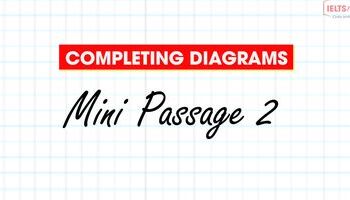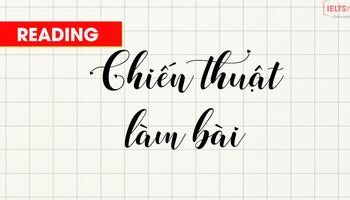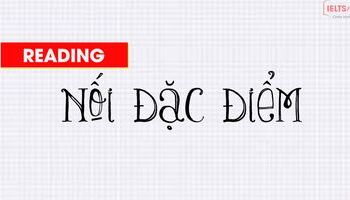I. REVIEW
Trong tất cả các dạng ra đề của bài thi IELTS Reading, thì các bạn thích dạng bài tập nào nhất nhỉ? Riêng IELTS-Fighter thì yêu thích dạng Completing Diagrams nhất, vì có hình nhìn sẽ cách làm bài và giải một đoạn văn mẫu thuộc loại bài tập này nhé.
Khi làm bài các rất sinh động đúng không nào ^^ Hôm nay chúng ta cùng nhau nghiên cứu bạn chú ý những điễm sau:
- Kiểm tra số lượng từ được phép viết;
- Nghiên cứu biểu đồ và cố gắng hiểu ý chính. Không giành quá nhiều thời gian vào bước này;
- Gạch chân keywords;
- Xác định loại từ cần điền và cố gắng đoán câu trả lời;
- Scan bài văn và xác định thông tin ở đoạn nào;
- Đọc kĩ để tìm câu trả lời;
II. MINI PASSAGE
Bây giờ chúng ta cùng nhau giải một bài mẫu nhé:
B For the first time, dictionary publishers are incorporating real, spoken English into their data. It gives lexicographers (people who write dictionaries) access to a more vibrant, up-to-date vernacular language which has never really been studied before. In one project, 150 volunteers each agreed to discreetly tie a Walkman recorder to their waist and leave it running for anything up to two weeks. Every conversation they had was recorded. When the data was collected, the length of tapes was 35 times the depth of the Atlantic Ocean. Teams of audio typists transcribed the tapes to produce a computerised database of ten million words.
C This has been the basis - along with an existing written corpus - for the Language Activator dictionary, described by lexicographer Professor Randolph Quirk as “the book the world has been waiting for”. It shows advanced foreign learners of English how the language is really used. In the dictionary, key words such as “eat” are followed by related phrases such as “wolf down” or “be a picky eater”, allowing the student to choose the appropriate phrase.
D “This kind of research would be impossible without computers,” said Delia Summers, a director of dictionaries. “It has transformed the way lexicographers work. If you look at the word “like”, you may intuitively think that the first and most frequent meaning is the verb, as in “I like swimming”. It is not. It is the preposition, as in: “she walked like a duck”. Just because a word or phrase is used doesn’t mean it ends up in a dictionary. The sifting out process is as vital as ever. But the database does allow lexicographers to search for a word and find out how frequently it is used - something that could only be guessed at intuitively before.
E Researchers have found that written English works in a very different way to spoken English. The phrase “say what you like” literally means “feel free to say anything you want”, but in reality it is used, evidence shows, by someone to prevent the other person voicing disagreement. The phrase “it”s a question of crops up on the database over and over again. It has nothing to do with enquiry, but it’s one of the most frequent English phrases which has never been in a language learner’s dictionary before: it is now.
F The Spoken Corpus computer shows how inventive and humorous people are when they are using language by twisting familiar phrases for effect. It also reveals the power of the pauses and noises we use to play for time, convey emotion, doubt and irony.
Questions 7-11
The diagram below illustrates the information provided in paragraphs B-F of Reading Passage 127
Complete the labels on the diagram with an appropriate word or words Use NO MORE THAN THREE WORDS for each space.
Write your answers in boxes 7-11 on your answer sheet.
III. DISCUSSION
Các bạn đã suy luận như nào và đáp án thật sự ra sao, bây giờ hãy cùng IELTS Fighter nghiên cứu nhé.
Yêu cầu: Đáp án không nhiều hơn 3 từ
(7) Cần một tính từ đi chung với cụm từ “written corpus”. Từ “corpus” khó có thể paraphrase nhưng từ written thì có nhiều cách paraphrase hơn. Box số 7 cùng với Spoken Corpus Computer -> Language Activator
-->> Teams of audio typists transcribed the tapes to produce a computerised database of ten million words.
-->> This has been the basis - along with an existing written corpus - for the Language Activator dictionary,
-->> Từ this thay thế cho câu phía trên.
-->> Đáp án: existing
(8) Cần một đáp án là danh từ, đi chung với từ “key words"
-->> key words such as “eat” are followed by related phrases such as “wolf down” or “be a picky eater”, allowing the student to choose the appropriate phrase.
-->> Đáp án: Related phrases
(9) Cần danh từ số nhiều, đi chung với cụm so sánh nhất “Most frequently used” và từ ”words”
-->> If you look at the word “like”, you may intuitively think that the first and most frequent meaning is the verb,
-->> Đáp án: meanings
(10) Cần tính từ, dự đoán là đối lập với tính từ “written” và đi chung với danh từ “difference” hoặc các synonyms của nó
-->> Researchers have found that written English works in a very different way to spoken English.
-->> Đáp án: Spoken
(11) Cần danh từ, đi chung với từ khóa “portrayal”, “feeling”. Cùng với Example đã được làm -> Spoken Corpus Computer.
-->> The Spoken Corpus computer shows how inventive and humorous people are when they are using language by twisting familiar phrases for effect. It also reveals the power of the pauses and noises we use to play for time, convey emotion, doubt and irony.
-->> Đáp án: Noises and pauses
Các bạn ơi, khi làm dạng bài Completing Diagrams, chúng ta nên chú ý các dấu mũi tên nhé. Những dấu mũi tên này sẽ định hướng cho chúng ta vị trí đáp án cần tìm và các keywords đi chung với đáp án nhé.
Chúc mọi người học tốt <3





